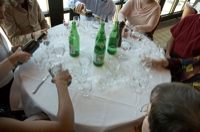This is the first part of an article on the Tea Leaves amari tasting panel. Today we will talk about the arrangements and participants, and tomorrow we will discuss the panel’s reactions to the liqueurs.
Their names roll off the tongue: Fernet. Nonino. Averna. Their tastes — unusual, herbal, and exotic — can seem almost indescribable. They are the amari, powerful Italian digestifs.
My first exposure to amari came in Italy. Standing in a bar sipping a macchiato, a somewhat grizzled gentleman walked in and said, in a gravelly voice, “Averna”. The barkeep poured a thick, dangerous looking liquid into a shotglass, the gentleman finished in a gulp, put the glass on the bar, and walked out. I asked the barista what it was, and he explained that it was a digestivo. “It’s something you might drink if your stomach was a little unsettled.”
Later in the same trip, after a long day of walking in the sun, I felt a bit queasy. “Obviously, alcohol is the solution to this problem,” I said to myself. In the next bar I came to, I said “Averna,” trying as best I could to sound like I knew what I was getting myself into.
It was not like other drinks. It was strong-tasting, but also subtle. It was sweet. And it was bitter. And it did settle my stomach.
Standing next to me at the bar was an older Italian man, staring at me. I nodded a greeting. “How can you drink that stuff?” he said, in English. I asked him what he meant. He shook his head sadly. “You people, you British, you Americans, you come over here and you drink all these awful things. I don’t understand. We don’t drink that stuff. We drink whisky.” He gestured with his glass for emphasis. I shrugged, and he wandered away, tumbler of scotch in hand.
Something about the strangeness of that encounter left a mark on me. I was curious about these unfamiliar drinks. In Italy they are valued for their medicinal and digestive properties. In America, the only liqueur of this style that could be called popular is the German Jägermeister, a concoction favored by college students because of the apocryphal belief that the various herbs in it will have a cough-syrup like effect on the imbiber. Why are the amari so ignored here?
The theory I’ve come up with is: fear. Trillin’s syndrome, the fear that someone else ordered a better meal than you did, applies to beer, wine, and liquor as well. In America, alcohol is very much a social lubricant, a prop, a badge of identity, and a point of discussion. Ordering a drink you don’t like is more than just a let-down, it’s actually a social faux-pas. “Are you so naive that you don’t even know what you like to drink?” But of course, the only way to learn what to order, if you’re not willing to experiment, is to mimic others. Which brings us to our present situation, where there are only five drinks (not counting beer, wine, and slurpees with booze in them) that most people ever order: gin and tonic, rum and coke, vodka and anything, whiskey, and the martini. And the martini has been so emasculated that most people who drink them still don’t know what vermouth tastes like.
Fear can be overcome by knowledge. That, more than anything, was what motivated me to create a tasting panel for amari. The panel’s goal was to taste some of the best Italian amari and describe them in enough detail that people could order them (or buy them at a liquor store) and have some idea of what they were about to try. With that in mind, I contacted Lidia’s of Pittsburgh restaurant in the Strip District — they have the best amari selection in the region — and asked them if they were interested in sponsoring the tasting.
Dave Wagner, the managing partner at Lidia’s, got in touch with me. When you float a proposal about an event like this, you expect that you might hear back from a store manager, or from the organization’s special events coordinator. What you don’t expect is for one of the owners to get a hold of you and say “Yes, this is a great idea. We’re going to do it.” But that’s exactly what happened, which is one reason why I’m about to say some very nice things about Lidia’s. The other reason is that I happen to love the place.
What consistently impresses me about Lidia’s is that their ambition precisely matches their abilities, and they know it. From the decor straight down to the details of the menu, Lidia’s manages to be both elegant and modestly understated at the same time. Every time I walk into the place I am confused by how they manage this. I imagine the restaurant itself speaking to me: “Oh, that chandelier that you can’t take your eyes off of? That’s just made from some blown glass. We apologize that it’s not nicer.” “These perfectly-executed ravioli? Why, the mixture inside is very simple, just spinach and cheese. We hope you like it.” “Ah, yes, we have this wine list with some very unassuming wines. We figured we’d just charge $20 for each of them. Is that OK?”
You can walk in dressed to the nines and feel perfectly at home, but if you show up in jeans and a t-shirt they don’t give you even the slightest whiff of attitude (I know: I’ve done it). I think the secret to the place is that the atmosphere is firmly focused on being a complement to the food, rather than the other way around. It’s part of their presentation, it enhances the experience, but fundamentally what they are selling is well-executed, straightforward Italian cuisine. The dishes are not presented as more than they are, but neither are they dumbed down. And they love their own food.
It is this that came through when talking to Dave Wagner about amari. Lidia’s estimates that they probably sell, overall, maybe a bottle or two of amari over the course of a year. That’s how few people drink these liqueurs. And while I’ve no doubt that some people are going to try amari as a result of reading these articles, I’m sure Mr. Wagner doesn’t expect the Amari Division of Lidia’s to suddenly become a huge profit center overnight. They sponsored our panel tasting because they love amari, and think it would be wonderful if more people learned about them. They did it because they care about eating and drinking. The next time you have a lousy meal at a pretentious restaurant, ask yourself if you think they actually care about their food. And if you answer “no,” then do yourself a favor and make a reservation at Lidia’s, instead.
Based on his enthusiasm, his experience, and his interest, then, Dave Wagner was the first member of our panel. Allow me to introduce the others.
Lidia Bastianich
I was surprised and delighted that Lidia joined us on the panel. She’s a chef, an author, a restauranteur, and a TV personality, and was preparing to celebrate her Pittsburgh restaurant’s 4th anniversary. Her plate, so to speak, was absolutely full. I thought she might come, shake hands, say a few words about amari in general, and leave.
Instead, she sat down, ate with us, and spent two hours talking with us about food, amari, and culture. She was gracious and witty. It only takes about five minutes with her to understand the restaurant’s attitude towards food. She speaks of food as something that isn’t only sustaining and pleasing, but spiritually fulfilling as well. She doesn’t just love food, she respects it.
But more than that, she listened. It would have been easy for her to simply assume the role of teacher and tell us which drinks we should like, and why. Instead, she was interested in seeing how our various palates reacted to the different amari, and how we felt about them. It was an honor to have dined with her.
John Barbera
John Barbera is an architect at the firm of Penner and Associates. John rescued us at the last moment when one of our panelists fell ill and couldn’t make it. The thing about John is: he’s a perfectionist. I have a feeling this is a trait that serves him well in his work. The other thing about John is that he wears these cool architect glasses. A few months ago, I read an article in the New York Times that, in summary, said “Architects wear cooler glasses than the rest of us.” After reading that article, I started paying attention, and I realized the author was right. If I wore John’s glasses, I would look dorky, but on him they look great.
I suspect that there must be some sort of fashion class in the last year of architecture programs where they teach you how to wear the cool glasses and still look good.
I need to take this class.
Kilolo Luckett
Kilolo Luckett has seven years of experience in arts and architecture management working in for-profit and non-profit sectors. Currently, Kilolo works at Cool Space Locator, a nonprofit community and economic real estate organization. She matches small businesses to unique spaces in urban neighborhoods. After earning her Bachelor of Arts in History of Art and Architecture from University of Pittsburgh in 1998, Kilolo worked as a summer art instructor for Manchester Craftmen’s Guild. She was the curatorial assistant at The Pittsburgh Cultural Trust’s Wood Street Galleries. She is actively involved in numerous civic and cultural organizations. Recently, she served on the David L. Lawrence Convention Center Public Art Committee, and was selected by the Pittsburgh Foundation and Heinz Endowments as a working group member
for The Creativity Project.
Kilolo, in other words, is awesome. Any uncertainty about how the event would go evaporated once Kilolo agreed to be involved. It is a metaphysical impossibility for any event with which she is involved to go wrong.
Steve Posti
Steve is a librarian, a would-be farmer and a dad. Originally from Pittsburgh, he and his wife lived in South Florida for 12 years before returning to Pittsburgh in 2003.
Steve was, in fact, the very first person to volunteer for the tasting panel. I was a bit nervous inviting someone that I hadn’t met to be on the panel, but Steve is a librarian. I like librarians. So for the record let me say: if you’re going to go out and drink, you definitely want a librarian with you. Steve asked interesting questions, kept the conversation moving, and was a great contributor. I’m glad he was there.
Steve and his family live in Mt. Lebanon, where his wife Jo is running for a seat on the
school board.
Ann Funge
“I’m just a chick from Jersey,” Ann claims, but the truth isn’t that simple. Ann strides the halls of the law offices of Wilder & Mahood, bringing hope to her clients and striking fear into the hearts of her opponents. Ann’s sharp wit is matched only by her overflowing compassion for beasts and children. Balancing a nearly insatiable curiosity for the use of arts and sciences to bring peace and prosperity to all with a frankly down to earth sensibility about the efficacy of mangonels and trébuchets to forcefully end sieges of walled cities, Ann is a true renaissance woman. Perhaps her most significant character trait, though, is her nearly beatific willingness to not sue me for fabricating almost everything in her biography.
My biggest fear in inviting Ann to participate was that she wouldn’t be able to find time in her schedule to make it. Fortunately, I was able to entice her by exploiting her fascination with my motives. “Wait, so you for write this weblog thing. And…how do you make money on it? You mean you just called up Lidia’s and asked them to sponsor this? Why are you doing this, really?” I’m pretty sure that she still thinks I have some master plan to option the movie rights to “The Amari Tasting Story” and retire to Tahiti, but of course, nothing could be further from the truth. (Note to Hollywood: Have your people call my people. Let’s do lunch.)
Laura Valentine
Laura is willing to try almost anything in the interests of science, as long as it is fun or presents a high potential for hilarity. Unfortunately, her husband will not let her dye the cats with Easter egg dye, but this is only a temporary setback in her research into rainbow-colored kittens. Other hobbies include smoking cigars, gardening, and frothing criticism of prepackaged foodstuffs.
Laura is also the author of one of my favorite food weblogs, Upside-Down Pear. She doesn’t flood you with useless articles on everything she thinks of, but instead picks her battles, and is always right about everything.
I was sure Laura was a good choice because she’s well-spoken, and while culinarily adventurous, she would not see the adventure as an end in and of itself. In other words, I knew that Laura would be willing to stand up and announce, in the face of peer pressure to be noncomittally nice, “This is terrible.”
Laura also cares about words, an attribute that I think is generally admirable.
Peterb
And, of course, I was there too.
The guidelines for the panel were straightforward. Be bold in your opinions. Express preferences. Try to describe what you’re drinking, not show how sophisticated you are. I wanted to take these vague adjectives people use about amari — “bitter,” “assertive” and the like — and turn them in to specific descriptions, so that someone who hasn’t tried them might have some idea of what they’ll find if they try one.
The stage was set. The panel had arrived. Six bottles and forty-eight glasses waited on a nearby table.
But first we had to eat.
Amari are digestivi. They lie on that odd fault line between the sensual and the medicinal. At one point, I had suggested that we could dispense with a full meal, because I was eager to get to the drinks. Lidia’s lips pursed ever so slightly. “They’re meant to be enjoyed at the end of a meal,” she said. There was the merest suggestion of a sigh. “But, if that’s how you want to do it….” Immediately aware that I had just suggested something equivalent to ordering tiramisu as an appetizer, I quickly backed off and tried to recover. “No, no. We should do it, uh, exactly the way you just suggested. In every way. Uh, ma’am.”
We spoke of the history of amari throughout the meal. People have been infusing alcoholic drinks with herbs since antiquity for reasons of both preservation and taste. Lidia traces the Italian amaro tradition back to the Romans, although our modern vermouth is probably closer to their drink than are today’s distilled amari. One can try to guess at the ingredients, but they are typically many, varied, and kept absolutely secret. Dave Wagner told the story of the time he was visiting makers of Amaro Nonino, in Friuli, and asked them to give him at least a hint of what went in to their infusion. “Of course,” his host smiled, “just as soon as you tell me the formula for Coca-Cola.”
While you may never know the full list of ingredients for any one amaro, there are certain ingredients that appear again and again. Anise regularly appears, as do juniper berries. The flavor of wormwood can often be detected. In the fruitier amari, the most common starring role is given to the bitter orange (Citrus Auranium var. Myrtifolia, which the Italians call chinotto.) No two amari taste exactly the same.
We spoke also of the restaurant itself — why Pittsburgh was chosen (“It’s a manageable location, midway between New York and Kansas City,”) and the constant quest for fresh local ingredients. We spoke of the work they’ve done with local farmers. “When we first arrived, we couldn’t even find rapini. It was terrible. Now, fortunately, things are much better.” I mentioned my delight at finding that their executive chef Craig Richards enjoyed Tram’s Kitchen, one of my favorite unassuming local restaurants, which has great food but no atmosphere. Dave Wagner smiled. “Of course. Especially with chefs, you’ll find that it’s really all about the food.”
As dinner came to a close, the plates were cleared away, leaving us with an array of empty glasses. The bottles were passed around, and we began to pour. The waiting was over. Now, after all the talk and anticipation, we would put our palates to the test.
In the next installment: the Tea Leaves panel tries to describe the indescribable. Please read it here.














Peterb! Why must you post incredible stuff when I am trying to *work*? Have you not been informed that I have deadlines?
You know what would increase my productivity *right now*? If I stopped coding, ate a fabulous meal, and then finished it off with a lot of alcohol. Yeah, that would do it. I’m sure my project would be done in record time.
Thanks.
What, and you don’t think having a nice relaxing drink will help you concentrate? Our economy was practically _built_ on the 3-martini lunch.
Or something.
Peter. Darling.
You are indeed a very handsome man.
But you are *not* Sean [censored] Connery.
Alright, so some restaurant in some distant town gave some people some alcoholic beverage to taste. This is laudable and perhaps even interesting to those who like their drinks written in italics. Whatever happened to _Playable Classics_, though?
-pvg
Some things are more important than video games.
>Some things are more important than video games.
Some things, indubitably, are. Say, going to the bathroom or the rulings of the Supreme Court. But I (perhaps, mistakenly) do not come to tleaves.com for such things. I was lured here with talk of Playable Classics. I was lied to. I may forgive but I will not forget.
-pvg
Secretly, my first intended Playable Classic was derailed when I realized that because it required you to press TWO buttons, the open-source port of Star Control II (The Ur-Quan Masters) was in fact disqualified by the rules I set out. So I’m wrestling with whether I just say “heck with it,” and change the rules, or find another first Playable Classic to cover.
I’ll have that decision made by next week.
Amari
To understand, you have to understand my first experience with amari. I was at Peter’s house, I’d been eating some aged provolone and drinking red wine, and I walked into the kitchen and someone handed me a glass of Cynar and told me to try it.
I…